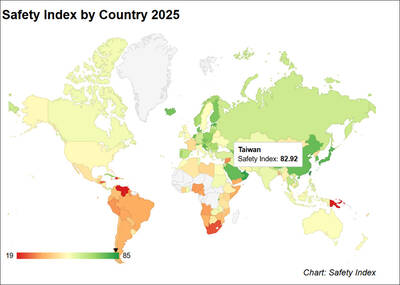China’s air force yesterday carried out another round of long-range drills, flying into the Sea of Japan (known as the “East Sea” in South Korea), prompting South Korean jets to scramble, and again around Taiwan amid growing tension over Beijing’s assertiveness in the region.
China has in recent months ramped up its long-range air force drills, particularly around Taiwan.
Chinese People’s Liberation Army Air Force spokesman Shen Jinke (申進科) said in a statement that fighter and bomber aircraft flew through the Tsushima Strait that separates South Korea from Japan and into international waters in the Sea of Japan, adding that the Sea of Japan is not Japan’s, and the drills were lawful and reasonable.
He described the exercises as routine and pre-planned.
In Seoul, South Korea’s Joint Chiefs of Staff said that five Chinese military planes were spotted entering the South Korean air defense identification zone, and fighter jets scrambled in response.
The Chinese aircraft also flew through Japan’s air defense identification zone, it added.
“Our fighter planes took normal tactical measures, identifying the models of the Chinese planes and flying aerial surveillance until they left,” the South Korean statement said.
Shen alluded to the scrambled aircraft, saying they “responded to interference from foreign military aircraft,” but were able to achieve the aim of their drill.
There was no immediate reaction from Japan’s government.
Taiwan’s military said that China had staged a separate drill at the same time, flying through the Bashi Channel between Taiwan and the Philippines, and then returning to base through the Miyako Strait, to Taiwan’s north and near Japan’s southern islands.
Taiwan monitored the situation as Japan sent F-15 fighters to intercept, the Ministry of National Defense said in a statement.
After taking leave from a scheduled appearance at the Legislative Yuan in Taipei, Minister of National Defense Feng Shih-kuan (馮世寬) yesterday morning oversaw the nation’s response to the Chinese air patrol by attending an intelligence briefing at the Heng Shan Military Command Center, a facility nestled deep under the mountains surrounding Taipei that serves as the military’s main command and control center in case of an emergency.
Presidential Office spokesman Alex Huang (黃重諺) said Chinese actions, such as its air patrols, are increasing military tensions, and might have a negative and harmful effect on peace and stability throughout the region.
“Such actions are irresponsible and they are not welcomed by the international community,” he said.
The Chinese air force last week conducted “island encirclement patrols” near Taiwan, after a senior Chinese diplomat threatened that China would invade Taiwan if any US warships made port visits there.
China’s air force exercises also come amid regional tensions over North Korea’s nuclear and missile programs, with bellicose rhetoric from both North Korea and US President Donald Trump.
Additional reporting by CNA

AIR SUPPORT: The Ministry of National Defense thanked the US for the delivery, adding that it was an indicator of the White House’s commitment to the Taiwan Relations Act Deputy Minister of National Defense Po Horng-huei (柏鴻輝) and Representative to the US Alexander Yui on Friday attended a delivery ceremony for the first of Taiwan’s long-awaited 66 F-16C/D Block 70 jets at a Lockheed Martin Corp factory in Greenville, South Carolina. “We are so proud to be the global home of the F-16 and to support Taiwan’s air defense capabilities,” US Representative William Timmons wrote on X, alongside a photograph of Taiwanese and US officials at the event. The F-16C/D Block 70 jets Taiwan ordered have the same capabilities as aircraft that had been upgraded to F-16Vs. The batch of Lockheed Martin

GRIDLOCK: The National Fire Agency’s Special Search and Rescue team is on standby to travel to the countries to help out with the rescue effort A powerful earthquake rocked Myanmar and neighboring Thailand yesterday, killing at least three people in Bangkok and burying dozens when a high-rise building under construction collapsed. Footage shared on social media from Myanmar’s second-largest city showed widespread destruction, raising fears that many were trapped under the rubble or killed. The magnitude 7.7 earthquake, with an epicenter near Mandalay in Myanmar, struck at midday and was followed by a strong magnitude 6.4 aftershock. The extent of death, injury and destruction — especially in Myanmar, which is embroiled in a civil war and where information is tightly controlled at the best of times —

Taiwan was ranked the fourth-safest country in the world with a score of 82.9, trailing only Andorra, the United Arab Emirates and Qatar in Numbeo’s Safety Index by Country report. Taiwan’s score improved by 0.1 points compared with last year’s mid-year report, which had Taiwan fourth with a score of 82.8. However, both scores were lower than in last year’s first review, when Taiwan scored 83.3, and are a long way from when Taiwan was named the second-safest country in the world in 2021, scoring 84.8. Taiwan ranked higher than Singapore in ninth with a score of 77.4 and Japan in 10th with

China's military today said it began joint army, navy and rocket force exercises around Taiwan to "serve as a stern warning and powerful deterrent against Taiwanese independence," calling President William Lai (賴清德) a "parasite." The exercises come after Lai called Beijing a "foreign hostile force" last month. More than 10 Chinese military ships approached close to Taiwan's 24 nautical mile (44.4km) contiguous zone this morning and Taiwan sent its own warships to respond, two senior Taiwanese officials said. Taiwan has not yet detected any live fire by the Chinese military so far, one of the officials said. The drills took place after US Secretary